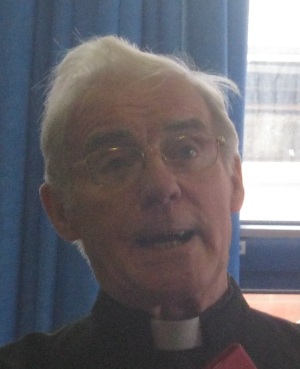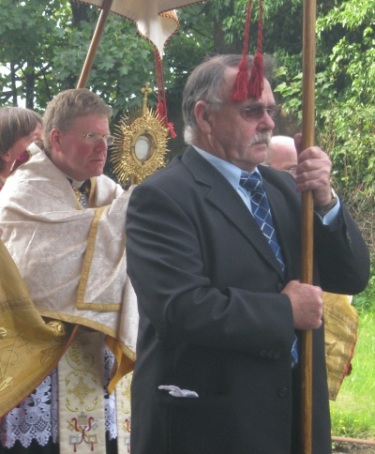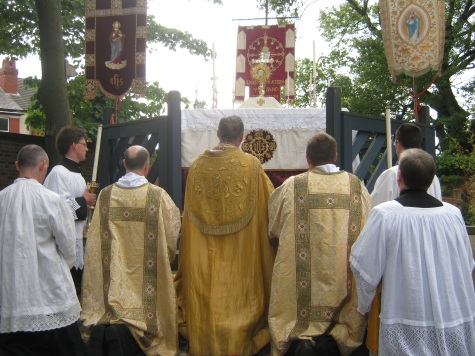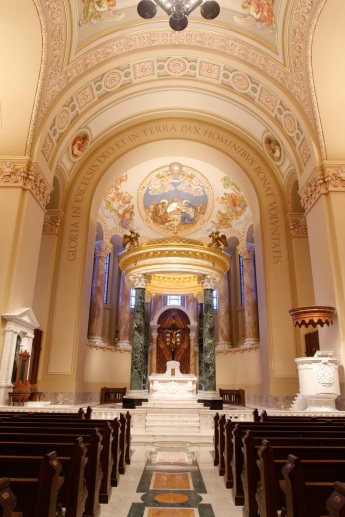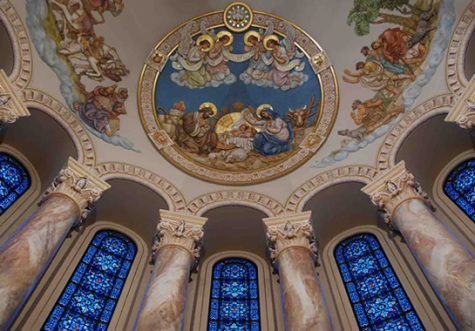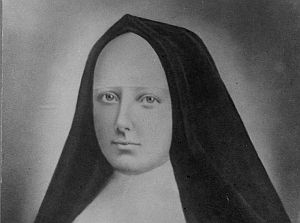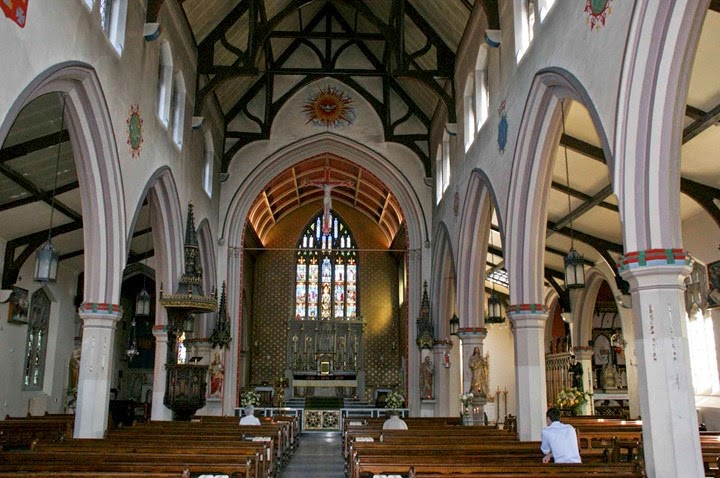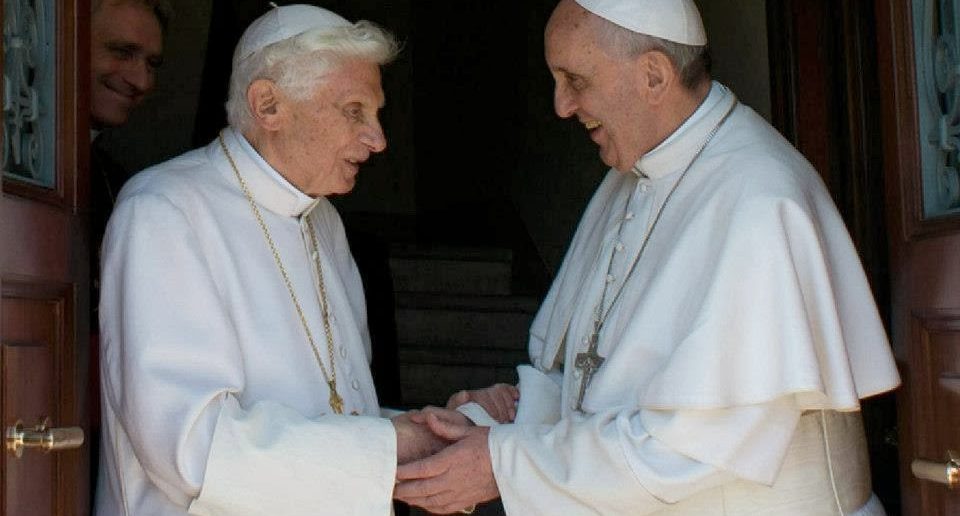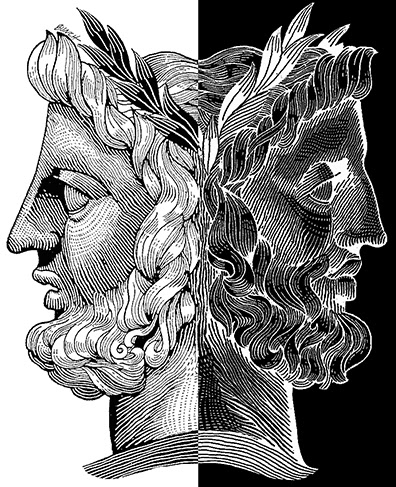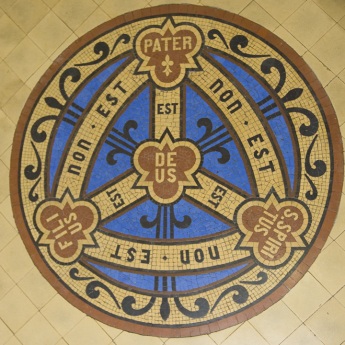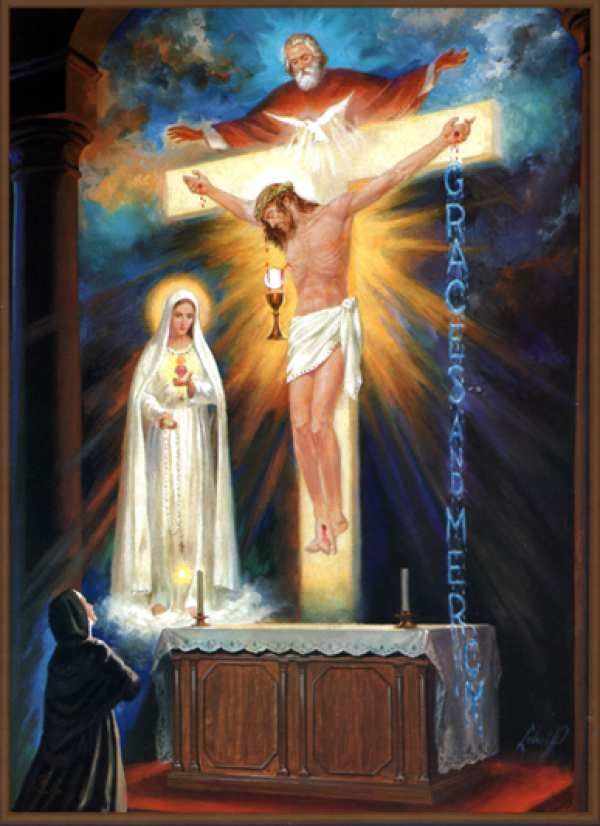Dominicae Cenae, 3: Let Our Adoration Never Cease
 Torch of The Faith News on Tuesday 31 May 2016 - 10:05:04 | by admin
Torch of The Faith News on Tuesday 31 May 2016 - 10:05:04 | by admin
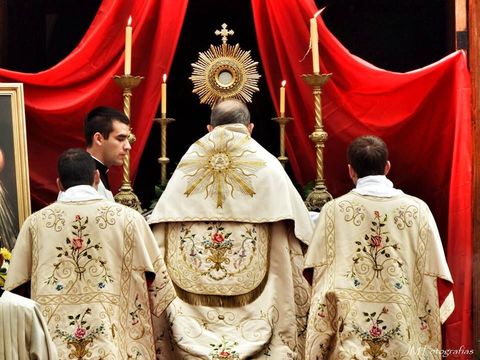
Eucharistic Adoration during the Corpus Christi celebrations at San Rafael, Mendoza, Argentina (from Accion Liturgica).
In these days following Corpus Christi, in a time when the Real Presence of Jesus Christ in the Most Holy Eucharist is so little adored, loved, respected or even known, it is worth reflecting afresh on these basics of our Faith; and sharing them with those we know and meet.
Catechism of the Catholic Church
The Eucharistic presence of Christ begins at the moment of the Consecration and endures as long as the Eucharistic species subsist. Christ is present whole and entire in each of the species and whole and entire in each of their parts, in such a way that the breaking of the bread does not divide Christ.
Worship of the Eucharist. In the liturgy of the Mass we express our faith in the Real Presence of Christ under the species of bread and wine by, among other ways, genuflecting or bowing deeply as a sign of adoration of the Lord. ''The Catholic Church has always offered and still offers to the Sacrament of the Eucharist the cult of adoration, not only during Mass, but also outside of it, reserving the consecrated Hosts with the utmost care, exposing them to the solemn veneration of the faithful, and carrying them in procession.'' (Catechism of the Catholic Church, CCC 1377 - 1378).
St. Thomas Aquinas
Godhead here in hiding, whom I do adore
Masked by these bare shadows, shape and nothing more,
See, Lord, at Thy service, low lies here a heart
Lost, all lost in wonder at the God Thou art.
Seeing, touching, tasting are in Thee deceived;
How says trusty hearing? that shall be believed;
What God's Son has told me, take for truth I do;
Truth Himself speaks truly, or there's nothing true.
Adoro te devote.Â
Fr. Jack McLeish - Requiescat in Pace
 Torch of The Faith News on Monday 30 May 2016 - 10:54:50 | by admin
Torch of The Faith News on Monday 30 May 2016 - 10:54:50 | by admin
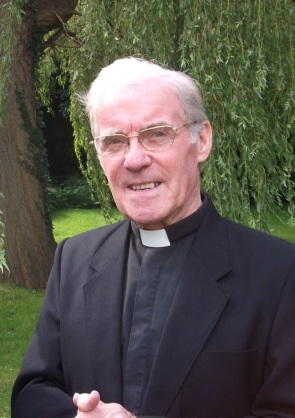
Of your charity, please pray for the repose of the soul of Fr. Jack McLeish, who died peacefully on 24th May, 2016.
Fr. McLeish was born in Manchester in 1935 and received his seminary formation at the English College, Lisbon, during the 1950's.
After ordination in 1959, Fr. McLeish served as an assistant priest in a number of parishes in the Shrewsbury Diocese, prior to becoming the parish priest of St. Edwards, Macclesfield in 1973. Between then and his retirement from full-time parish ministry in September 2010, Father served as the parish priest at six different parishes of the Shrewsbury Diocese, at locations in Cheshire and Shropshire.
On 13th May, 2012, we attended a presentation given by Fr. McLeish, during the celebrations of Our Lady of Fatima, at the Shrine Church of Ss Peter, Paul and Philomena in New Brighton.
Father McLeish's presentation was particularly engaging because he had met and befriended the families of the Fatima seers during his years at the Lisbon seminary in Portugal. He was thus able to convey to us their first-hand experiences of the Miracle of the Sun in 1917. That made him an important secondary source of historical evidence. In addition to that, Father's talk was notable for providing a very human dimension to the miraculous and profoundly important events impacting on our times and the future of the Church and world. After his talk, Fr. McLeish made himself available for questions and handled these in an affable and lighthearted manner.
Although Fr. McLeish's death is a great loss to the Church Militant on earth, comfort can be taken from the knowledge that the day of his death was just one day after his 57th-anniversary of priestly ordination; and was also the feast of Our Lady Help of Christians, the patroness of the Shrewsbury Diocese.
Father McLeish's funeral details are as follows: Sunday, 5th June, 7pm - Reception of the body and vigil Mass at St. Michael and All Angels, Woodchurch, Wirral. Monday, 6th June, 11:30 am - Requiem Mass and Funeral at St. Michael and All Angels, Woodchurch. Â
Eternal rest grant unto him, dear Lord; and let perpetual light shine upon him; and may he rest in peace. Amen.Â
Our Lady of Fatima - Pray for us!Â
Corpus Christi and Being Part of Something Much Bigger Than Yourself
 Torch of The Faith News on Sunday 29 May 2016 - 09:18:46 | by admin
Torch of The Faith News on Sunday 29 May 2016 - 09:18:46 | by admin
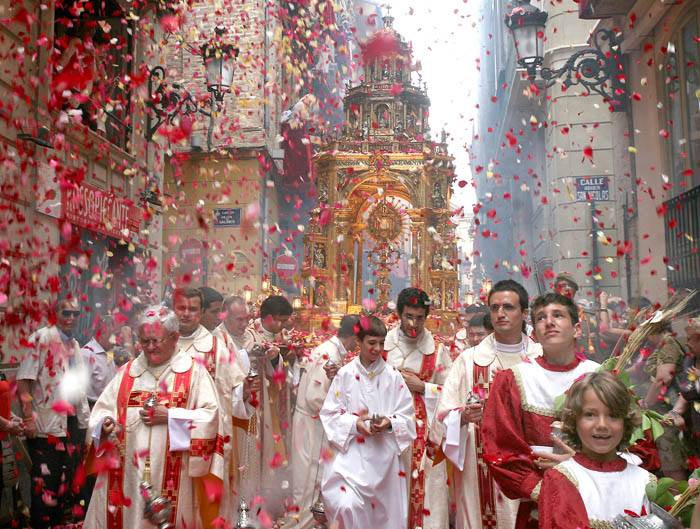
Panis vivus et vitalis!: Bread Which lives and maketh live!
How beautiful is the Christ-centred feast of Corpus Christi! It struck us today, how participation in this annual celebration, with all the splendour of its Eucharistic Processions, enables one to experience being caught up into something much bigger than oneself.
That truly satisfies a need which is deeply felt by all human beings.
And how!
First, and most importantly, this is because the feast is not primarily about us, but about Jesus Christ. That makes it really stand out in the midst of a culture which has become so dominated by selfish narcissism.
And yet, though centred on Christ, it is also about the participant, who is invited into a deep union, indeed a communion, with Our Lord Jesus Christ.
It enables participants to walk with - and even to receive the Benediction of - Our Lord Jesus Christ, Who is Really Present, Body, Blood, Soul and Divinity, in the Blessed Sacrament, held aloft by the priest's veiled hands, in the golden Monstrance, at the head of the procession.
Then again, it is to be part of the Universal Church in a very tangible way. It is to rediscover oneself as a member, however small and seemingly insignificant, of Christ's Mystical Body.
It is to tread in Christ's sacred footprints, in union with the saints in Heaven, the holy souls in Purgatory and all those who do their best to walk with Christ in the Church Militant on earth; whether these latter be present in the procession itself, present in processions at other localities or, prevented by illness, infirmity or the lamentable lack of a local procession in these times, are present in their hearts, minds and wills.
Related to this is the experience of walking in common with others who believe in Christ's Real Presence and in His Church. Such experiences of community are especially valuable in an age which is largely cold to God and objective truth; and wherein widespread narcissism and preference for pets and technology over persons has left so many feeling isolated, lonely and neglected.
Another aspect of being caught up into something much bigger is that participation in the Corpus Christi procession allows one to physically and spiritually continue, and take forward, a celebration which was extended to the Universal Church as long ago as 1264 AD; having first been introduced locally in Flanders around 1246 AD.
The Corpus Christi procession, then, allows us to partake of a tradition which puts us in touch with the deepest traditions of our European culture and civilization. Deeper than that: it puts us into contact with the very deepest mysteries of human existence. As our forefathers in Christendom understood, the Sacred Host at the heart of the Church was the centre and power behind all true unity.
As we noted on last year's feast, Christ's Real Presence in the Eucharist brought unity in the spheres of the heart and the mind; the body and the soul; man and woman; parents and children; the family and wider society; the priest and the people; the parish and the diocese; the diocese and the Universal Church; the local culture and the wider Christian civilization; the Church and State; the seasons of religion, culture and nature; the fields of leisure, prayer and work; the ailing and the physically healthy; the living and the dead; Heaven and earth.
And of course, all of these unities flowed from that greatest of all unities: the unity of God and Man brought about by the Incarnation and the Miracle of Transubstantiation.
Although there is always tension and a tendency to disunity in human affairs - due to selfishness, sin and the attacks of the infernal enemy - the overall charitable unity brought about by the Real Presence at the heart of Christendom and the Church remains a truly remarkable phenomenon in the history of human societies.
Of course, every single celebration of the Holy Sacrifice of the Mass puts one in touch with these central realities. However, the annual celebration of Corpus Christi , with its joyful processions, has a special way of calling them to the centre of one's attention once again.
These are just some of the reasons why it is such a blessing to see these traditional processions growing again in parts of England; not least through the efforts of the traditionalist communities and other traditional Catholic priests and laity.
The Corpus Christi processions provide an invaluable public witness to the people of our time; especially as there is something deeply irresistible and human about joining on with marches and processions. We've all seen even the most shy of guests tagging on to the conga line at parties!
So, what are you waiting for? Join the Church's procession through history to the brightest of futures in Christ! Â Â
Beauty, Goodness and Truth
 Torch of The Faith News on Saturday 28 May 2016 - 12:28:16 | by admin
Torch of The Faith News on Saturday 28 May 2016 - 12:28:16 | by admin
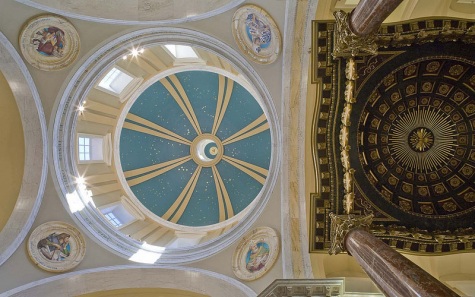
Raising the heart and mind to God: A view upwards to the beautiful dome and baldacchino in the Shrine of Our Lady of Guadalupe in La Crosse, Wisconsin. This magnificent shrine was constructed between 2004 - 2008 under the leadership of Cardinal Raymond Burke and the architectural expertise of Duncan G. Stroik.Â
It is heartening to see that the religious and classical architect Duncan G. Stroik has been awarded the Arthur Ross Award for 2016. This is the oldest award in the United States of America for the recognition and celebration of excellence in the classical architectural tradition.
Duncan G. Stroik and his architectural masterpieces constitute an encouragingly counter-cultural presence in these days of trial for the Church and Western civilization.
We first encountered Stroik's inspirational architecture around a dozen years ago through reading Michael S. Rose's contributions in the books The Renovation Manipulation; Ugly as Sin: Why They Changed Our Churches from Sacred Spaces to Meeting Places - and How We Can Change Them Back Again; and In Tiers of Glory: The Organic Development of Catholic Church Architecture Through the Ages. In the face of several decades of theological, liturgical, catechetical, artistic and architectural deconstructionism, the work of Duncan G. Stroik stood out clearly to us as an example of recovery, continuity and legitimate development of the classical and Catholic artistic patrimony.Â
When we were at Steubenville we met a young lady who was hoping to go on to study classical art and architecture in order to help with the restoration of traditional Catholic churches in America. She was well schooled in Christopher Dawson's grasp of the unity of religious and cultural history; and she spoke enthusiastically to us of the splendid works of Duncan G. Stroik as a benchmark example of architectural quality.
Stroik's portfolio is so beautiful that simply perusing it on-line can be an exercise in prayerful contemplation.St. Joseph's Cathedral in Sioux Falls, South Dakota. Originally completed and dedicated in 1919, Duncan G. Stroik's major renovation was completed in 2011. The result is quite simply a revelation.
As these images show, Stroik's portfolio ranges from completely new constructions, like the Shrine of Our Lady of Guadalupe in Wisconsin, to extensive renovations, such as the Cathedral of St. Joseph in South Dakota. His transformative renovation of the sanctuary in the parish church of St. Therese in Sugar Land, Texas, shows just how much good can be achieved even when the starting point represents a more modern architectural setting.Â
St. Therese's Church in Sugar Land, Texas: Before and After the architectural attention of Duncan G. Stroik.
Just to give a feel for the theological truth underpinning so much of Stroik's work, here is a revealing quote from 5th December, 2012 at the New Liturgical Movement.
Over the years, I have sought to recover the idea of the tabernacle as the ark of the new covenant and relearn the rich tradition of its design. What is a worthy temple for the God Who offers Himself for our salvation? When the Body of Christ is reserved within it, the tabernacle becomes the dwelling place of the Creator of the Universe. Even though the tabernacle is the smallest element inside a church, it holds the full grandeur of God.
A closer view of the domed sanctuary ceiling at St. Joseph's Cathedral in Sioux Falls, South Dakota.
As New Liturgical Movement reports today, Stroik's work ''is animated by the conviction that beautiful and durable architecture ennobles mankind and honours the Creator.'' Stroik's architectural gems certainly look like beautiful places where one's heart and mind would be easily encouraged to soar towards God. Such is the universal appeal of beauty that observers of all persuasions must surely agree that they are places where one would simply like to be. This very human, and yet numinous dimension, was part of the evangelizing appeal and potential of the majority of Catholic churches in the days before the depredations of Modernism took hold.Â
Stroik's work is thus a very positive movement in contemporary Catholic art and architecture. It is therefore highly encouraging to see him receiving the Arthur Ross Award this year. Hopefully, as with that young lady in Steubenville, Stroik's work and rewards will encourage another generation of aspiring artists and architects to work for the restoration of Catholic art, architecure and sound liturgical practice in the times ahead.
We highly recommend that readers spend some time perusing Stroik's on-line portfolio. As we said above: It is a work of prayer. Â
''I Must Give Myself to My Saviour!'' An Account of a Eucharistic Miracle and an Amazing Conversion
 Torch of The Faith News on Friday 27 May 2016 - 12:48:13 | by admin
Torch of The Faith News on Friday 27 May 2016 - 12:48:13 | by admin
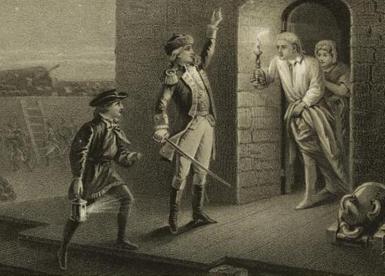
General Ethan Allen - American Patriot
Students of American history will likely be familiar with General Ethan Allen who, together with Benedict Arnold and the Green Mountain Boys, captured Fort Ticonderoga from the British during a surprise attack in May 1775.
Allen was a deist with extremely rationalistic opinions. As such, he became an outspoken critic of Christianity in general and of Catholicism in particular. He openly questioned the Bible, scorned the Church's respect for miracles as ''superstition'' and described Catholic priests as ''holy cheats''. Allen's disdain for revealed religion was perhaps most clearly expressed by the title and content of his treatise Reason, the Only Oracle of Man.
The historical record suggests that at least one of his religious opponents described Allen as dying in a state of horror and despair. Of course, there can be workings of God's grace through Christ and His Church which are not chronicled in the historical record.
Fanny Allen
On the other hand, there is a happier aspect which, though sadly too-little known today, is well documented in primary sources.
I speak of the amazing converison story of General Allen's young daughter Frances Margaret Allen - affectionately known as Fanny Allen - who not only converted to the Catholic Faith, but became the very first New England Woman to become a Catholic nun. Fanny's father died when she was just 4 years of age. Eventually her mother married Dr. Jabez Penniman and he cared for Fanny as though she were his own daughter.
Although the new family appears to have been nominally Protestant, Dr. Penniman looked down on expressions of the religious people of his time as being pretentious.
Fanny herself was more interested in science than religion, but she expressed a desire to receive education from the Catholic nuns at the Congregation Convent in Montreal. It is thought that this was primarily to satisfy an intellectal curiousity about Catholic beliefs and practices.
That Fanny did not take religion seriously can be gathered from the fact that, still unbaptised, she had to receive Baptism from the local Anglican minister prior to heading off for Montreal. She later said that she only went through with this to please her mother. Indeed, it even seems that she was scolded by Rev. Daniel Barber for laughing all the way through the baptismal ceremony. As an interesting side note, Barber would also eventually convert to the Catholic Faith in later years.
Although Fanny at this time comes across as disturbingly irreligious, there is an interesting episode relating to the Providence of God working in her life. When she was 12 years old, she had a strange mystical experience one day on the banks of a river near to the family home. An animal, described as being more like a monster of extraordinary size and horrible shape than a mere fish, suddenly emerged from the water and came directly towards her. The fearful young Fanny felt herself to be paralysed and rooted to the ground. At that moment a man with a venerable and striking countenance, wearing a brown cloak and bearing a staff in his hand, advanced towards her and took hold of her arm. At that point, Fanny felt her strength return and the man kindly asked her what she was doing there and told her to hasten away. When she had run some distance, Fanny turned around but the venerable man was not to be seen.
A Disruptive Young Lady
Notwithstanding this unusual mystical experience during her youth, Fanny Allen became a disruptive presence in the Congregation Convent at Montreal. She was unhappy and, sad to relate, mocked openly at the rites of Holy Church.
Fearing the scandal and spiritual harm this behaviour might cause to the other young ladies, the Reverend Mother decided that she must ask Fanny to return home. A sister who had become attached to the well-being of the young Protestant girl asked the Mother to allow an extended probation period until the feast of the Nativity of Mary, on the 8th September, 1807. The extension was permitted, but Fanny showed little sign of improvement.
A Eucharistic Miracle and an Amazing Conversion
As the feast drew near, she spoke her doubts and thoughts to the religious sisters in words which deeply grieved them. Still, she did help them to prepare flowers for Benediction of the Blessed Sacrament.
The good Sister was about to take the completed vase to the chapel, when she suddenly bade Fanny to do so instead. Miss Allen laughed when the Sister admonished her to be sure to adore Our Lord while she was there.
As she approached the High Altar, Fanny reflected that she did not believe and wondered why she should bow before the altar. In her home town Catholics were mocked as idolaters. She would not become one. At that point she reached the sanctuary gate, opened it, and attempted to go further.
Fanny then experienced another intriguing episode of being powerless to move. She attempted to do so three times, but could not get her feet to move forward.
Overcome by awe and an unsual compelling influence, Fanny fell upon her knees and made the first act of faith in her entire life. Her God was indeed present in the sacred Tabernacle and she knelt before Him humbled and ashamed. She was then able to rise and place the flowers reverently upon the altar.
''After such a miracle, I must give myself to my Saviour.'' Fanny resolved to become a Catholic and, eventually, a religious sister.
In reaction to these events, Fanny's family removed her from the convent and attempted to distract her with lavish parties, handsome suitors and the apologetics of a High Church Episcopalian minister. Her family and friends became amazed at the change in Fanny and her earnest resolve to be faithful to her promise. She was eventually instructed in the Catholic Faith and re-baptised by Fr. L. Saunier, who discerned that she had not been properly disposed for her earlier baptism to be valid. At her First Holy Communion, Fanny resolved to give herself to the Lord as a Catholic nun. To placate her family, she agreed to take no action for a whole year.Â
The Fatherly Care of St. Joseph
The following year Fanny and her mother visited the Hotel-Dieu de Montreal convent together. Above the High Altar in the convent chapel, Fanny noticed a representation of the Holy Family. Amazed, she remarked to her mother that the image of St. Joseph exactly matched the appearance of the venerable gentleman who had saved her from the river creature when she was a girl of just 12 years of age. ''See, dear mother, St. Joseph, wants me here!'' she exclaimed. The amazed Fanny also stated: ''Oh, great St. Joseph, it is indeed you, the foster father of Jesus, the husband of Mary, who came to save me from that monster, to preserve me from death, that I might enjoy the benefit of knowing, loving and serving my God. It is right here, mother, it is with the Sisters of St. Joseph that I wish to spend the rest of my life.''
Fanny's mother and step-father had previously imagined Catholic convents to be little more than joyless prisons; they were given great peace of mind after visiting the Hotel-Dieu nuns and seeing both the happiness of the sisters in the community and the happiness of Fanny in their presence.Â
A Holy Life and a Holy Death
Fanny Allen made her final religious profession on 18th May, 1811. The convent chapel was packed with her family and many American friends who were amazed to see the outspoken and rationalistic General Ethan Allen's daughter becoming a Catholic nun.
Sister Allen became a nursing sister, acting as an interpreter for English-speaking patients in the French-speaking hospital and even caring for wounded combatants from the War of 1812.Â
The convent records show that Sister Allen died a most holy death from lung trouble on the 10th December, 1819. She was buried beneath the Hotel-Dieu convent chapel.Â
We pray that the graces and example of Sister Allen's life will encourage all of us to love Jesus in the Blessed Sacrament and to live holy lives for love of Him. As she said herself: ''After such a miracle, I must give myself to my Saviour!'' May it be so for each one of us too.
Feast of Corpus Christi
 Torch of The Faith News on Thursday 26 May 2016 - 09:07:36 | by admin
Torch of The Faith News on Thursday 26 May 2016 - 09:07:36 | by admin
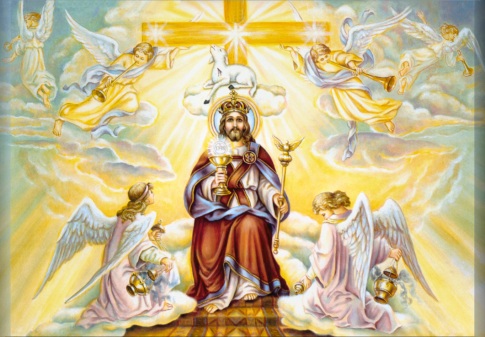
The churches are always open: all can go to converse with the King of Heaven whenever they wish. Jesus desires that we speak to Him with unbounded confidence; it is for this purpose that He remains under the species of bread (St. Alphonsus de Liguori).
The Sacrament of Love
The Catholic Church presents to men the Blessed Sacrament as the answer to the deep cry of the soul after love. She tells us, that in Holy Communion is received God entire - the Body and Blood, the Soul and Divinity of Our Lord Jesus Christ... There is another reason why God should give Himself to man. It is this: whatever is received as food, must in some way partake of the life it goes to support or sustain; otherwise, starvation and death follow. This is a loss of all attraction and life. Now, in the Christian soul, there is a divine life; a divine food, therefore, is necessary for its support, growth and perfection.
The Catholic Church tells us that we receive the divine food in Holy Communion. Jesus Christ confirms what she teaches.
Thus the Catholic Saviour is not an abstract Saviour, nor a dead Saviour, separated from us by nineteen centuries, but a real, living, personal Saviour, dwelling in the midst of us, even in our very hearts - our heart's life!
The Real Presence of Jesus Christ in the Holy Communion, connected as it is with the great Sacrifice of the Mass, is the central mystery of the Catholic Faith (after the Most Holy Trinity). It is the complete, full, and adequate expression of God's love to man. God cannot do more. God cannot love more. If it were not for this, to look for a fuller manifestation of God and His love to man might be admitted; but now to think or dream of such a thing is a mark of folly.
When we consider that God is really and truly present on the altars of the Catholic Church - that He is the guest of the Catholic heart, its life and its nourishment - is it to be wondered at that this Church has given birth to so many hero saints, and martyrs, and still continues to do so? Oh, life becomes great, noble, divine, under the influence, and in the participation of so great mysteries!
Is it not, we ask, a sufficient evidence of the divinity of the Catholic faith, that it elevates the human heart to the belief, that it receives, in the Sacrament of Holy Communion, Almighty God? Is not this an audacity of faith and love, which none but God Himself can inspire, sustain and perpetuate in poor, weak, and human hearts?... Is not this the completion of all man's wants, the end of man's supreme desire?
(A reflection on the Most Holy Eucharist by the Servant of God, Fr. Isaac Thomas Hecker, founder of the American Paulist Fathers, who lived from 1819 - 1888. During his earthly life, he made extensive use of the pulpit, the lecture circuit and the printing press with the evangelistic aim of converting America to the Catholic Faith).
We pray that our readers will receive many graces appropriate to this Feast of the Body and Blood of Our Lord Jesus Christ.
Some Traditional Latin Masses for Corpus Christi in the North West of England
 Torch of The Faith News on Wednesday 25 May 2016 - 13:08:18 | by admin
Torch of The Faith News on Wednesday 25 May 2016 - 13:08:18 | by admin
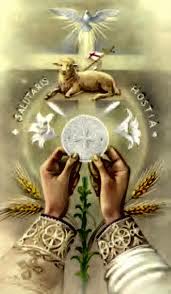
Although the Bishops of England and Wales have transferred the celebration of the great feast of Corpus Christi to this coming Sunday, there are a number of places also offering the Traditional Latin Mass tomorrow - 26th May 2016- in the north west of England. Although this list may not be exhaustive, we know of the following venues:-
New Brighton
ICKSP Shrine Church of Ss Peter, Paul and Philomena, Atherton Street, CH45 9LT.
9am - Low Mass
7pm - Sung Mass (Followed by Corpus Christi Procession in Church).
N.B - There will also be a Sung Mass for the Solemnity on Sunday 29th May, followed at 11:30 by a Blessed Sacrament Procession through the streets of New Brighton. At 12:30pm, there will be a social in the hall.
Leyland
St. Catherine Laboure, Farington, PR25 4QG.
7pm - Sung Mass - Followed by a celebratory glass of wine and light refreshments.
Liverpool
St. Anthony's, Scotland Road, L5 5BD.
12pm - Low Mass
Lydiate
Our Lady's, Southport Road, L31 4HH.
7pm - Low Mass
Manchester
English Martyrs, Alexandra Road South, Whalley Range, M16 8QT.
7pm - Low Mass
Preston
ICKSP Shrine Church of St. Walburge, Weston Street, PR2 2QE.
7pm - Sung Mass
Shrewsbury
St. Winefride's, Crowmere Road, Monkmoor, SY2 5RA.
7:30pm - Low Mass
St. Helens
Holy Cross, Corporation Street, WA10 1EF.
6:00-6:55pm - Adoration of the Blessed Sacrament (with Confessions available from 6:15-6:45pm)
7pm - Low Mass with Benediction of the Blessed Sacrament
Warrington
FSSP Shrine Church of St. Mary, Buttermarket Street, WA1 2NS.
12:10pm - Low Mass
7:30pm
Please Note: There will also be a Corpus Christi Procession to celebrate the Solemnity at 2pm on Sunday, 29th May. After the 11am Mass, there will be a convivial picnic in the Priory garden (please bring and share packed lunch and own seats/mats), followed by the outdoor procession.
Please also note that there will be Quarant' Ore in the splendid Oratorian Church of St. Chad in Manchester this weekend.
St. Chad's is located at Cheetham Hill Road, Manchester, M8 8GG.
The 40-Hours of Eucharistic Adoration will commence with Solemn High Mass at 5:30pm on Friday, 27th May and will conclude on Sunday 29th May with Solemn High Mass and a Corpus Christi Procession. There will be various devotions, such as the Rosary, Stations of the Cross and meditations on the Real Presence from the writings of the saints at set times during the 40-Hours.
Please pray for all of these priests who have gone the extra mile, so to speak, to provide these Holy Masses, Processions, traditional devotions and social activities in honour of the Real Presence of Our Lord Jesus Christ in the Blessed Sacrament.
Let us each draw near to His Sacred Heart.
Co-Workers For the Truth? Archbishop Ganswein Suggests 1 + 1 = 1... Except When It Also Equals 2!
 Torch of The Faith News on Tuesday 24 May 2016 - 12:33:25 | by admin
Torch of The Faith News on Tuesday 24 May 2016 - 12:33:25 | by admin
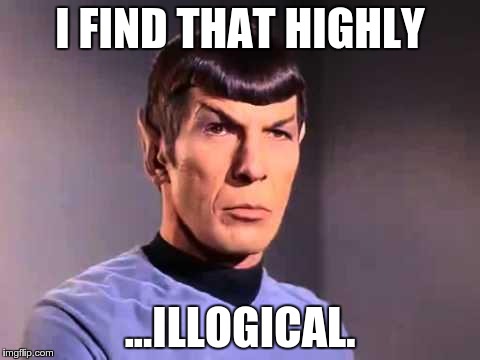
Fides et Ratio beautifully described faith and reason as two wings on which the human spirit rises to the contemplation of truth. There was no mention of two popes!
Say What?!!!
It is really very difficult for any right thinking person to provide a reasoned analysis of Archbishop Ganswein's 20th May speech to the Pontifical Gregorian University.
In light of all that is happening at the top of the Church, one has been tempted in the dark hours of the night to suppose that such were the intention...
Rorate Caeli provides the key information with links to important earlier articles from 2014.
More Bombshells from Rome
Yesterday was another of those days in which it was difficult to even know where to start writing here. This was due, in no small part, to two more bombshells which erupted in Rome in recent days.
On Friday, we learned of Pope Francis' homily at Casa Santa Marta, in which he appeared to twist the words of Our Blessed Lord in Matthew 19 to suggest the very opposite of their natural meaning.
Then there was the intrigue surrounding the sudden release by the Holy See's Press Office of a statement, attributed to Pope-Emeritus Benedict XVI, which firmly denied 1 Peter 5's report about Fr. Ingo Dollinger and the content of the Third Secret of Fatima.
Like many observers, we have given much thought to the fresh questions raised by the nature and content of this press release. For example: Why the rush to make this ''clarification'' when so many other things which much more urgently required clarification never received any? Some examples off the top of my head include: the urgent need to affirm the constant teaching of the Magisterium on the worthy reception of Holy Communion and the indissolubility of valid marriage; the confusing claims emerging from the Eugenio Scalfari ''interviews''; the ambiguities of the ''smoking footnote'' in Amoris Laetitia; the mysterious downplaying of the meeting with Kim Davies, whilst playing up the meetings with homosexual and trans-sexual pairings; and the damaging claims of Archbishop Bruno Forte in his recent Zonalocale.it interview.
Why, too, does the Holy See Press Office statement not include the signature of Pope-Emeritus Benedict, or even express itself in his usual manner?
Whatever the answers to these questions, it is clear from the many commentators at 1 Peter 5 that the Holy See Press Office has sadly lost the respect and trust of many informed Catholic lay people. And who can be surprised given the slick manoeuvres carried out during Synods '14 and '15, or the way that men on its staff, such as Fr. Thomas Rosica, have comported themselves in relation to the Catholic faith and the Catholic faithful?
Archbishop Ganswein - Rome's Equivalent of Colonel Edward M. House to Benedict XVI's Woodrow Wilson?
And then we come to Archbishop Ganswein's latest speech at the Pontifical Gregorian University.
From the shadows Archbishop Ganswein grins on a very unusual scene: Although I had long admired His Grace, I never did understand how Archbishop Ganswein could so fawningly participate in Pope Francis' radical break with Sacred Tradition in the multi-religious prayer event in the Vatican Gardens on Pentecost Sunday 2014.
From the One Rock of Peter to a Post-Modern Diarchy?
As is clear from the translations provided at Rorate Caeli, Archbishop Ganswein has suggested that Pope Benedict XVI ''profoundly and lastingly'' transformed the papacy in February 2013.
In admitting that the election of Pope Benedict XVI in the Conclave of 2005 was ''certainly the outcome of a battle'' between the Ratzingerians and the ''so-called St. Gallen group'', Ganswein has also suggested that the ''key'' to interpreting the Conclave was Cardinal Ratzinger's famous ''dictatorship of relativism'' homily as Dean of the College of Cardinals.
The most startling ''revelation'' to emerge from Ganswein's speech is his claim that Pope Benedict has not abandoned his ministry. Instead, he suggests that Pope Benedict has built a personal office with a collegial and synodal dimension, almost a communal ministry as if he had wanted to reiterate once again the invitation contained in his motto of co-workers with the truth.
The next section of Ganswein's speech, in which he contends that there are not two popes but de facto an expanded ministry - with an active member and a contemplative member is, frankly, illogical.
As an aside, the best response I have seen to that, so far, is the exchange between the commentator Tigga Wild and Steve Skojec at 1 Peter 5.
Wild says: ''So, there are not 'two popes' but also there is not one pope.'' To which Skojec replies: ''(((NERVOUS LAUGHTER INTENSIFIES)))''.
In light of Ganswein's reference to the ''dictatorship of relativism'' homily, his conclusions quoted at Rorate Caeli are nothing short of remarkable.
He states: ''So it is not surprising... that some have seen it as revolutionary, or otherwise as entirely consistent with the Gospel, while still others see in this way a secularized papacy as never before, and thus more collegial and functional, or even simply more humane and less sacred. And still others are of the opinion that Benedict XVI, with this step, has almost - speaking in theological and historical-critical terms - demythologized the papacy.'' Â
The Shadow of Hegel - Again?
In light of that multivalent conclusion, and indeed in respect of the rest of this confused and confusing speech, I find myself again shuddering during this papacy - these papacies??? - at the possible spectre of the Hegelian Dialectic.
Please allow me to explain.
Archbishop Ganswein has confirmed that there was indeed a battle between two groups at the Conclave of 2005. Although that in itself has major ramifications, let us consider a related issue which few seem to have spotted up to now.
In affirming the existence of the 2005 struggle between the Ratzinger supporters and the so-called St. Gallen mafia, Archbishop Ganswein has indirectly acknowledged the much publicised stories about the latter's preference for Cardinal Jorge Bergoglio.
He has gone on to affirm that Pope Benedict stepped down from the ''active'' ministry of the papacy, without stepping down from the ''contemplative'' ministry.
And we know that the one elected to take on this ''active'' ministry was none other than Cardinal Jorge Bergoglio - today's Pope Francis.
It has to be said that this synthesis of two opposed parties coming together in a new and radically transformative way is strangely, we might even say chillingly, reminiscent of the Hegelian or even the Marxist dialectic.
Applying the Hegelian model to this strange set of circumstances, the election of Pope Benedict would thus be seen as the Thesis.
The struggle against this by the St. Gallen mafia and their ''candidate'' would be seen as the Anti-Thesis.
And finally, the ''merging'' of the papacy of Pope Benedict with a new papacy of Pope Francis, by ''expanding'' the papacy into two contemplative and active ''parts'' would represent a new Synthesis.
Time to Brush Up On Your Knowledge of Blessed Anne Catherine Emmerich's Prophecies?
Whatever the truth of this analysis, the members of the entire Church have just been absolutely stunned by Archbishop Ganswein's claims.
The ancient Roman God Januarius: Is it perhaps this, rather than Christ's, that the Modernists' prefer as their model of the papacy?
By suggesting that Pope Benedict always intended to maintain the contemplative dimension of the papacy, in a new model of the papacy as a diarchy, Ganswein has affirmed what writers such as Fr. Paul Kramer and Antonio Socci have maintained all along.
That such an attempt to maintain a part of the papacy goes against Sacred Scripture, Sacred Tradition, Canon Law and even the explicit teachings of the Second Vatican Council, should surely be understood by everyone.
Questions of legality and even validity surely arise? If so, the Church would have to investigate this very seriously. Then the question arises: Who in the present hierarchy has the theological knowledge, the goodwill and the courage to do anything about it?Â
In a strange way, those troubling words of Blessed Anne Catherine Emmerich on 13th May (!) 1820 just took on an even darker and more mysterious hue: ''I saw also the relationship between the two popes... I saw how baleful would be the consequences of this false church; I saw it increase in size; heretics of every kind came into the city (of Rome). The local clergy grew lukewarm and I saw great darkness...''
As a postscript to all of this, we also read late last night that Pope Francis had just met in Rome with Sheik Ahmed el-Tayyib, the Grand Iman of Al-Azhar. What was particularly strange about the MSM reportage was that this meeting was being hailed as a bid to bring the Catholic and Muslim ''churches''Â together.
The word ''churches''Â was used repeatedly.
It is as though the two religions are now being presented as merely different branches of one religion.
And who can doubt that this is the impression given by Pope Francis since his multi-religious prayers in the Vatican Garden at Pentecost 2014? Or from his various actions and indifferentist-sounding comments regarding other religions and peoples?
Indeed, the Daily Mail wrote: ''Dialogue between the two churches ended under the reign of Francis' predecessor, Pope Benedict, when he quoted a Byzantine emperor as saying some of the prophet Muhammed's teachings were evil and inhuman.''
In light of all that is happening, perhaps we had all better brush up on our Blessed Anne Catherine Emmerich...
... and our Akita, Fatima, La Salette and Quito!
St. Peter the Rock on Which Christ Built His Holy Church - Pray for us!
Feast of the Most Holy Trinity
 Torch of The Faith News on Sunday 22 May 2016 - 11:35:44 | by admin
Torch of The Faith News on Sunday 22 May 2016 - 11:35:44 | by admin
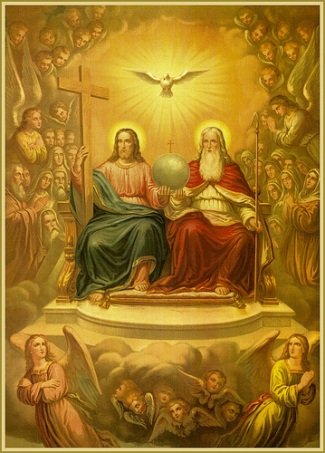
Gloria Patri, et Filio, et Spiritui Sancto. Sicut erat in Principio, et nunc, et semper, et in saecula saeculorum. Amen.
The Catechism on the Most Holy Trinity
The mystery of the Most Holy Trinity is the central mystery of Christian faith and life. It is the mystery of God in Himself. It is therefore the source of all the orther mysteries of faith, the light that enlightens them. It is the most fundamental and essential teaching in the hierarchy of the truths of faith. The whole history of salvation is identical with the history of the way and the means by which the one true God, Father, Son, and Holy Spirit, reveals Himself to men and reconciles and unites with Himself those who turn away from sin (CCC 234).
The Trinity is a mystery of faith in the strict sense, one of the mysteries that are hidden in God, which can never be known unless they are revealed by God. To be sure, God has left traces of His Trinitarian Being in His work of creation and in His Revelation throughout the Old Testament. But His inmost Being as Holy Trinity is a mystery that is inaccessible to reason alone or even to Israel's faith before the Incarnation of God's Son and the sending of the Holy Spirit (CCC 237).
Example of a Trinity Shield motif: The Father, the Son and the Holy Spirit are One God; not in the oneness of a single Person; but in the Trinity of One Substance; Distinction in Persons, Unity in Essence and Equality in Majesty.
The Traditional Latin Missal
The doctrine of the one Nature and Three Persons in God is not an abstract metaphysical tenet, but a fundamental doctrine of the Church, which is taught repeatedly throughout the Sacred Liturgy. We adore God the Father, Creator of the World; God the Son, Saviour of mankind; God the Holy Ghost, Sanctifier of souls. We see in the Holy Trinity the mystery of the eternal life of the Divine Being, Knowledge and Love. We should adore, bless and thank the Holy and Undivided Trinity, on which all depend, from which all truth, goodness and beauty proceed.
Prayer of St. Catherine of Siena to the Most Holy Trinity
O eternal Trinity, You are a deep sea in which the more I seek the more I find, and the more I find, the more I seek to know You. You fill us insatiably, because the soul, before the abyss which You are, is always famished; and hungering for You, O eternal Trinity, it desires to behold truth in Your light. As the thirsty hart pants after the fount of living water, so does my soul long to leave this gloomy body and see You as You are, in truth.
O unfathomable depth! O Deity eternal! O deep ocean! What more could You give me than to give me Yourself? You are an ever-burning Fire; You consume and are not consumed. By Your fire, You consume every trace of self-love in the soul. You are a Fire which drives away all coldness and illumines minds with its light, and with this light You have made me know Your truth. Truly this light is a sea which feeds the soul until it is all immersed in You, O peaceful Sea, eternal Trinity! The water of this sea is never turbid; it never causes fear, but gives knowledge of the truth. This water is transparent and discloses hidden things; and a living faith gives such abundance of light that the soul almost attains to certitude in what it believes.
13th June 1929: Sr. Lucia of Fatima receives the vision of the Blessed Trinity and Our Lady of Fatima in the convent chapel at Tuy in Spain.
You are the supreme and infinite Good, good above all good; good which is joyful, incomprehensible, inestimable; beauty exceeding all other beauty; wisdom surpassing all wisdom, because You are Wisdom itself. Food of angels, giving Yourself with fire of love to men! You are the garment which covers our nakedness; You feed us, hungry as we are, with Your sweetness, because You are all sweetness with no bitterness. Clothe me, O eternal Trinity, clothe me with Yourself, so that I may pass this mortal life in true obedience and in the light of the most holy faith with which You have inebriated my soul.
We wish every grace and blessing to our readers on this great Feast of Trinity Sunday!
May Processions this Weekend in North West of England
 Torch of The Faith News on Saturday 21 May 2016 - 15:04:43 | by admin
Torch of The Faith News on Saturday 21 May 2016 - 15:04:43 | by admin
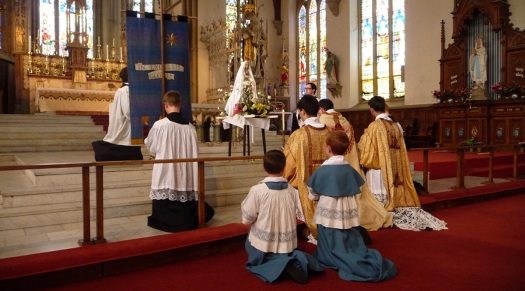
There are two traditional Marian Processions scheduled to take place this Sunday 22nd May 2016Â in the north west of England. The details are as follows:-
1. Preston - ICKSP Shrine Church of St. Walburge.
10.30 am - Traditional Sung Mass followed by May Procession in honour of Our Lady.
St. Walburge's Shrine, Weston Street, Preston, Lancashire, PR2 2QE.
2. Warrington - FSSP Shrine Church of St. Mary.
11:00 am - Traditional Sung Mass followed by May Procession. Weather permitting, the procession will head to the Lourdes Grotto in the Priory Garden, singing Marian hymns. One of the young ladies from the parish will carry a crown to place on the head of the statue of Our Lady.
St. Mary's Shrine, Buttermarket Street, Warrington, WA1 2NS.
O Mary! We crown thee with blossoms today,
Queen of the angels, and Queen of the May!  Â





